|
|
8 KYU - BLUE BELT
|
|
WARNING: THIS PAGE COULD BE UPDATED AT ANY TIME, SO YOU SHOULD REVIEW IT OFTEN
Here you will find all of the
information that you will need to prepare you for your grading. This information includes
your theory and your practical test. I hope this information will help you in giving
you a better understanding about Kyokushin Karate and also gives you a better
understanding of your requirements and at the same time helps you to study and
prepare for it.
MEANING OF THE BELTS
Below you will find a possible interpretation of the symbolism of the belt colors. I hope this will give a further understanding the sense in which the Obi (belts) colors mean. Belts colors are not only to reflect growth in technique, but also in character.
The Blue Belt (Fluidity - Adaptability)
Many people reach
this rank. This represents the water that comprises the oceans, air and
atmosphere. It has a power within it self. The student is introduced to
Karate, as a child is introduce to life. The basic movement and concepts
introduced are like the initial steps taken by a young child as they begin to
walk. This first steps provide the frame work that will allow him/her to run
tomorrow, and feel confident enough to find his/her own way. During this
period the students develop coordination and balance. At the same time the
students begin to work on their bodies, specially on their strength and flexibility.
Also, at this level the students should develop a better control of their mind and
body which would help to overcome the hard training.
![]()
WHAT YOU SHOULD KNOW FOR YOUR
KYOKUSHIN THEORY TEST
8 KYU - BLUE BELT
Below are some vocabulary you should be able to know in order to do your grading.
|
vocabulary 8 |
|
|
Name |
Meaning |
|
Jun
Tsuki Tate Tate Tsuki Tate Kudasae Uraken Hizo Mawashi Uraken Hizo Uchi Uraken Mawashi Uchi Shuto Sakotsu Shuto Sakotsu Uchi Enkei Gyaku Enkei Gyaku Tsuki Yoko Keage Yoko Keage Gedan Mawashi Geri Mae Geri Jodan Morote Morote Uchi Uke Gedan Barai Chudan Uchi Uke Yoi Dachi Shizentai Sashi-te |
Off shoulders punch Vertical Vertical Punch Stand up (Stand up Vertical) Back Fist Spleen Roundhouse Back fist strike to the spleen Round house back fist to the back or side of the head Knifehand Collarbone Knifehand strike to the collarbone In a circular motion Reverse Reverse thrust in a circular motion Side/Lateral High kick Side high kick Low roundhouse kick High front kick Double / two hands Two hands block from the inside Lower block Middle inside block Ready stance; rather informal way of saying `shizentai' Natural stance (e.g, Yoi dachi) Blocking and moving forward into opponent |
YOU SHOULD KNOW AND HAVE A DETAIL UNDERSTANDING OF:
|
Who was Sosai Masutatsu Oyama (Biography) | |
|
History of Kyokushin | |
|
Taikyoku Sono San Kata | |
|
The meaning of Blue Belt |
![]()
Kyokushin Kata has its origins in :
TAIKYOKU ICHI, NI, SAN (OMOTE):
| Taikyoku Sono San (Movie, 1 Camera Movie, 3 Camera) |
The Taikyoku and Pinan URA Katas, or 'reverse' Kata were developed by Sosai masutatsu Oyama as an aid to developing balance and multi-direction combat skills.
![]()
Below you will find all what you need to know for your grading. It was designed to supply the students with information about their requirements for their grades. If you have any question regarding the requirements consult your teacher. The grading requirements in our school contain the following:
8th KYU - ( BLUE BELT )
NOTE: Please keep in mind that the students must pay the testing fees ($30) 2 weeks before they give the writing test. the testing fees cover the cost of the Belt and certificate.
| Time in Classes : 15 Months ( one class a week - 2 hours class ) |
Theory (including all the above):
| Students must know the previous syllabuses | |
| Meaning of : -
Kyokushin Calligraphy |
| 30 Hands Push Ups | |
| 20 Knuckle Push Ups | |
| 30 Deep Knee Bends With Front Kick | |
| 4 Min. Jump Rope | |
| 1Serie of Abdominal |
Stances - ( Dachi ) :
| Shizentai (Natural position) |
Punches - Strikes ( Tsuki - Uchi ) :
| Seiken Jun Tsuki Jodan (High off the shoulder punch) | |
| Seiken Jun Tsuki Chudan (Middle off the shoulder punch) | |
| Seiken Jun Tsuki Gedan (Lower off the shoulder punch) | |
| Seiken Tate Tsuki Jodan (High vertical punch) | |
| Seiken Tate Tsuki Chudan (Middle vertical punch) | |
| Seiken Tate Tsuki Gedan (Lower vertical punch) | |
| Uraken (Backfist) | |
| Uraken Hizo Uchi (Strike to spleen) | |
| Uraken Mawashi Uchi ( Roundhouse strike to temple or back of the head) | |
| Shuto (Knife Hand) | |
| Shuto Sakotsu Uchi (Knife hand strike to collarbone) | |
| Enkei Gyaku Tsuki (Reverse thrust in a circular motion) |
Blocks - ( Uke ) :
1.- Seiken Morote Chudan Uchi Uke (Double inside block)
2.- Seiken Chudan Uchi Uke / Seiken Gedan Barai (Middle inside block/Downward
block)
Kicks - ( Geri ) :
| Yoko Keage (Ascending side kick-do not bend your knees) | |
| Gedan Mawashi Geri (Roundhouse kick to the leg) | |
| Mae Geri Jodan Chusoku (High front kick, using the ball of the foot) |
Forms - ( Katas ) :
| Taikyoku Sono San (Movie, 1 Camera Movie, 3 Camera) |
Three-step sparring - ( Sambon-Kumite ) :
| Sanbon Kumite #9 ( seiken jodan oi tsuki-migi/seiken jodan oi uke-migi & seiken chudan gyaku tsuki-hidari ) | |
| Sanbon Kumite #10 ( seiken chudan oi tsuki-migi/seiken chudan uchi oi uke-miji & seiken chudan gyaku tsuki-hidari ) | |
| Sanbon Kumite #11 ( seiken gedan oi tsuki-migi / seiken gedan oi uke-migi & seiken jodan gyaku tsuki-hidari ) | |
| Sanbon Kumite #12 ( seiken chudan
oi tsuki-migi / seiken soto oi uke-miji &
seiken chudan gyaku tsuki-hidari) |
Combinations - ( Renraku ) :
1.- Using basic techniques ( hands techniques, striking and blocking )
Self Defense - ( Goshin Jitsu ) :
| Ippon Kumite ( One-step sparring, from #1 to #8 ).
1.- Defense against punches utilizing Soto Uke, Uchi Uke, Jodan Uke, Gedan Barai. 2.- Applying basic blocks to release from wrist grabs. 3.- Utilizing basic blocks with counter strike using seiken, uraken and hiji. 4.- Basic Sashi-te movements (blocking with basic block and moving forward into opponent) to counter with close range technique (hiji). | |
| Gyakute (Grappling,
Wrestling, Joint locking) Not required at this level. however it is important the students lear and understand at this level the following: 1.- Recognize people likely to cause the need to defend one's self. |
Sparring - ( Kumite ) :
1.-
Minimum of two Sparring of 3 minutes.
The students should be able to execute the techniques using any of the
stances. Also the students would be tested on any techniques from previous belt.
WARNING: THIS PAGE COULD BE UPDATED AT ANY TIME, SO YOU SHOULD REVIEW IT OFTEN
![]()
STANCES AND WEIGHT
DISTRIBUTIONS (DACHI)
| Natural Stance |
| Shizentai |
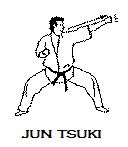 |
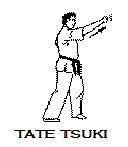 |
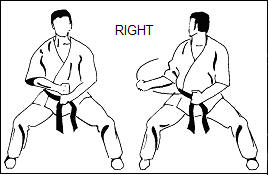 |
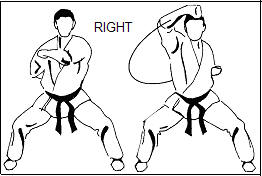 |
| URAKEN HIZO UCHI | URAKEN MAWASHI UCHI |
|
|
|
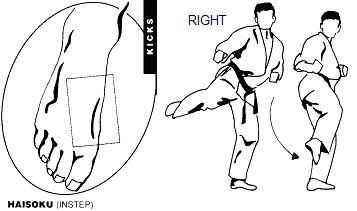 |
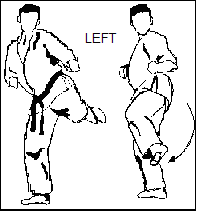 |
| GEDAN MAWASHI GERI HAISOKU | GEDAN MAWASHI GERI CHUSOKU |
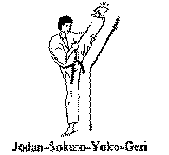 |
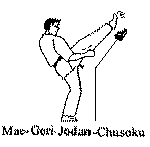 |
|
| Yoko Keage | Mae Geri Jodan Chusoku |
![]()
For more information
contact your teacher, sensei Angel Carrasco at:
angel@kyokushincanada.com
GO TO THE MAIN PAGE OF WINNIPEG KYOKUSHIN KARATE - DOJO ENTHEOS